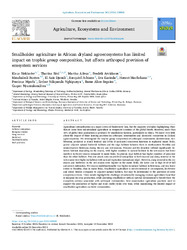| dc.contributor.author | Birkhofer, Klaus | |
| dc.contributor.author | Bird, Tharina | |
| dc.contributor.author | Alfeus, Martha | |
| dc.contributor.author | Arvidsson, Fredrik | |
| dc.contributor.author | Buxton, Mmabaledi | |
| dc.contributor.author | Djoudi, El Aziz | |
| dc.contributor.author | Fabiano, Ezequiel | |
| dc.contributor.author | Kasinda, Eva | |
| dc.contributor.author | Machekano, Honest | |
| dc.contributor.author | Mpofu, Precious | |
| dc.contributor.author | Nghipunya, Esther Ndapanda | |
| dc.contributor.author | Segaiso, Bame Alice | |
| dc.date.accessioned | 2024-02-05T09:40:40Z | |
| dc.date.available | 2024-02-05T09:40:40Z | |
| dc.date.issued | 2024-04-01 | |
| dc.identifier.citation | Birkhofer, K., Bird, T., Alfeus, M., Arvidsson, F., Buxton, M., Fabiano, E., ... & Nyamukondiwa, C. (2024). Smallholder agriculture in African dryland agroecosystems has limited impact on trophic group composition, but affects arthropod provision of ecosystem services. Agriculture, Ecosystems & Environment, 363, 108860. | en_US |
| dc.identifier.issn | 01678809 | |
| dc.identifier.uri | 10.1016/j.agee.2023.108860 | |
| dc.identifier.uri | http://www.journals.elsevier.com/agriculture-ecosystems-and-environment/ | |
| dc.identifier.uri | https://hdl.handle.net/13049/730 | |
| dc.description | The article is published under the CC BY 4.0 license. | en_US |
| dc.description.abstract | Agricultural intensification is a major driver of biodiversity loss, but the majority of studies highlighting these threats come from industrialised agriculture in temperate countries of the global North. However, more than 30% of global food production is produced by smallholder farmers, particularly in Africa. We know very little about the impact of these farming practices on arthropod communities and associated ecosystems in dryland agroecosystems. We investigated the trophic group composition of arthropod communities (detritivorous, herbivorous, predatory & mixed feeders) and levels of associated ecosystem functions in replicated maize fields, paired adjacent natural bushveld habitats and the edge habitats between them in north-eastern Namibia and central-eastern Botswana during the dry and wet seasons. Predator activity densities differed significantly between habitats depending on the season, with higher numbers in natural habitats in the wet season but lower numbers in the dry season compared to maize fields. In general, edge habitats had higher numbers of predators than the other habitats. Predator attack rates on artificial caterpillars in both seasons and dung removal in the wet season were higher in habitats with natural vegetation (natural and edge). However, dung removal in the dry season and herbivory in the wet season were highest in the maize fields, the latter due to high level of fall armyworm infestation. Wet season multifunctionality was higher in natural habitats in Botswana, and to a lesser extent in Namibia, than in maize fields. Smallholder agriculture is not detrimental to decomposers, herbivores and mixed feeders compared to adjacent natural habitats, but may be detrimental to the provision of some ecosystem services. These results highlight the challenge of sustainably managing dryland agricultural land that is marginal for crop production, while providing smallholders with an optimal environment to benefit from the ecosystem services associated with arthropod communities. New conservation agriculture practices need to support the production of higher and more stable yields over time, while maintaining the limited impact of smallholder agriculture on biotic communities. | en_US |
| dc.language.iso | en | en_US |
| dc.publisher | Elsevier B.V. | en_US |
| dc.relation.ispartofseries | Agriculture, Ecosystems & Environment;363, 108860 | |
| dc.subject | Artificial caterpillars | en_US |
| dc.subject | Biological control | en_US |
| dc.subject | Dung removal | en_US |
| dc.subject | Herbivory | en_US |
| dc.subject | Multifunctionality | en_US |
| dc.subject | Seed predation | en_US |
| dc.title | Smallholder agriculture in African dryland agroecosystems has limited impact on trophic group composition, but affects arthropod provision of ecosystem services. | en_US |
| dc.type | Article | en_US |

